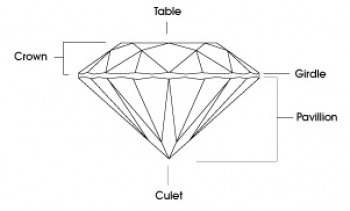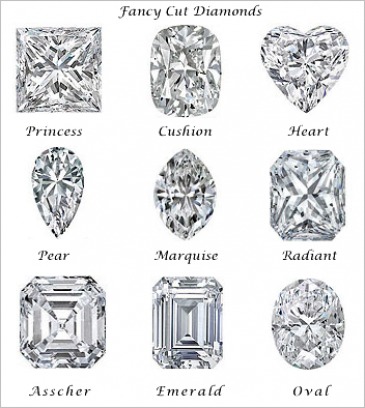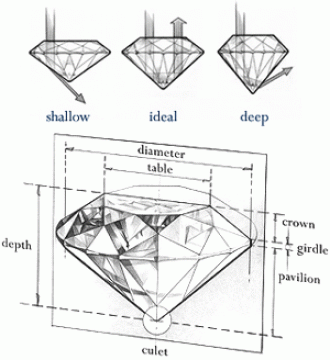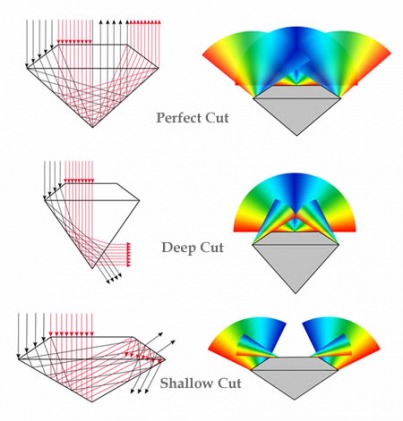Diamond Cut- The 3rd C of Diamond
The cut of a diamond is considered to be the most important characteristic for judging diamond quality. Even if the mined diamond has good clarity and desired color, the cut determines the overall look and feel of the gem. Cutting a diamond works like making finished product (gemstone) out of raw material (the mined diamond)
A cut refers to symmetry, polish and proportioning more importantly than the shape of cut (round, oval, cushion, square etc). A well cut diamond can even hide defects and impurities within and thus improve brilliance and color of the cut diamond, whereas a poor cut diamond would degrade a diamond’s quality and value.
A cut determines the amount of brilliance the gem would exhibit. It includes parameters like roundness, width, depth and face uniformity. Cut is most important as it is the only factor that determines the final presentation of the diamond. However, there is no universal standard which states the best and perfect proportions of a brilliant cut.
A cut refers to symmetry, polish and proportioning more importantly than the shape of cut (round, oval, cushion, square etc). A well cut diamond can even hide defects and impurities within and thus improve brilliance and color of the cut diamond, whereas a poor cut diamond would degrade a diamond’s quality and value.
A cut determines the amount of brilliance the gem would exhibit. It includes parameters like roundness, width, depth and face uniformity. Cut is most important as it is the only factor that determines the final presentation of the diamond. However, there is no universal standard which states the best and perfect proportions of a brilliant cut.
Diamond Light Dispersion Through its Cut
The dispersion and light reflection properties of a diamond depend mainly on its width and depth.
Diamonds are cut in many varied and exciting shapes. The shape of a diamond should not be confused with its cut. Shape refers to the basic form of the diamond. Cut or proportions, on the other hand, refer to the ability of each of these shapes to reflect light.
Defects in brilliance and light reflecting patterns can occur due to some areas in the gem which lack luster, also called “bow tie" effect, where the area appears like a bow tie. This is frequently found in marquise, oval, radiant, pear and some heart-shaped diamonds and can be observed with unaided eye. Almost every elongated stone has some bow tie effect, but one should try to find the one which shows minimal effect.
Types of Diamond Cut
When it comes to shape, it is simply comes down to personal preferences. The right shape for you is really the one whose appearance you prefer. Shape can be a statement of whom you are; like other areas of fashion, shape reflects your individuality and personality. Given below are some most common and popular diamond cut types.
The dispersion and light reflection properties of a diamond depend mainly on its width and depth.
Diamonds are cut in many varied and exciting shapes. The shape of a diamond should not be confused with its cut. Shape refers to the basic form of the diamond. Cut or proportions, on the other hand, refer to the ability of each of these shapes to reflect light.
Defects in brilliance and light reflecting patterns can occur due to some areas in the gem which lack luster, also called “bow tie" effect, where the area appears like a bow tie. This is frequently found in marquise, oval, radiant, pear and some heart-shaped diamonds and can be observed with unaided eye. Almost every elongated stone has some bow tie effect, but one should try to find the one which shows minimal effect.
Types of Diamond Cut
When it comes to shape, it is simply comes down to personal preferences. The right shape for you is really the one whose appearance you prefer. Shape can be a statement of whom you are; like other areas of fashion, shape reflects your individuality and personality. Given below are some most common and popular diamond cut types.
Round Brilliant Cut:
Diameter: The width of the diamond as measured through the girdle.
Table: The flat top and largest facet of a gemstone.
Crown: The top portion of a diamond extending from the girdle to the table.
Girdle: The narrow band around the widest part of a diamond.
Pavilion: The bottom portion of a diamond, extending from the girdle to the point of the stone.
Culet: The facet at the tip of a gemstone. The preferred culet is not visible with the unaided eye (graded "medium" or "none")
Depth: The height of a gemstone measured from the culet to the table.
Diameter: The width of the diamond as measured through the girdle.
Table: The flat top and largest facet of a gemstone.
Crown: The top portion of a diamond extending from the girdle to the table.
Girdle: The narrow band around the widest part of a diamond.
Pavilion: The bottom portion of a diamond, extending from the girdle to the point of the stone.
Culet: The facet at the tip of a gemstone. The preferred culet is not visible with the unaided eye (graded "medium" or "none")
Depth: The height of a gemstone measured from the culet to the table.
Fancy Cut Diamonds
Other fancy cut diamonds are marquise, pear, oval, heart, emerald, princess, radiant, etc.
Round brilliant cut is more symmetrical and easier to formulate proportionality and find optimum balance between brilliance and dispersion. But for other cuts the following parameters are generally kept in mind:
The fancy cut diamond should be symmetrical in the sense of both halves. The profile and top view should be carefully observed for symmetry of the two halves and both should have minimum possible difference. To save on weight, diamonds are sometimes deliberately cut with mismatched halves.
The fancy shaped diamond should be exhibit brilliance and should reflect good amount of light. There should be very little light reflection through the pavilion area of the diamond. If one finds both these qualities in the diamond, then it can be said to be well cut.
Pointed cuts, such as marquises, pears, and hearts, should have enough thickness at the end points to withstand normal wear and tear. A too shallow cut can reduce the thickness and make the gem vulnerable enough to be chipped off.
The cutting techniques for colored stones determine their color intensity. For example, Ceylon Sapphires have usually a pale color, are generally cut with deeper pavilion than the darker Siam Sapphires.
Other fancy cut diamonds are marquise, pear, oval, heart, emerald, princess, radiant, etc.
Round brilliant cut is more symmetrical and easier to formulate proportionality and find optimum balance between brilliance and dispersion. But for other cuts the following parameters are generally kept in mind:
The fancy cut diamond should be symmetrical in the sense of both halves. The profile and top view should be carefully observed for symmetry of the two halves and both should have minimum possible difference. To save on weight, diamonds are sometimes deliberately cut with mismatched halves.
The fancy shaped diamond should be exhibit brilliance and should reflect good amount of light. There should be very little light reflection through the pavilion area of the diamond. If one finds both these qualities in the diamond, then it can be said to be well cut.
Pointed cuts, such as marquises, pears, and hearts, should have enough thickness at the end points to withstand normal wear and tear. A too shallow cut can reduce the thickness and make the gem vulnerable enough to be chipped off.
The cutting techniques for colored stones determine their color intensity. For example, Ceylon Sapphires have usually a pale color, are generally cut with deeper pavilion than the darker Siam Sapphires.
Clarity is given importance in colored diamonds, which includes even color throughout the gem. In order to achieve this, very precise cutting angles and proportions are calculated for each facet. So there is a significant difference in cutting techniques for colorless and colored diamonds.
For colorless diamonds, the preferred cut type is round brilliant as compared to fancy cuts as they are costlier than colorless fancy cut diamonds. Cutting a round diamond includes 10% more loss in weight than what is lost while cutting fancy cuts. For colored diamonds, the most important parameters are beauty and sparkle, so the cut type depends on what can best amplify these two. That is why most color diamonds are fancy cut, with no impact on their price.
Along with intensification of color, the fancy cuts also offer more variety. The longer it takes the light to pass through a gemstone, more the absorption of light will occur, and the gem will appear darker. The diamond cutter’s aim is to reach a balance between the intensity and brilliance. The best known cuts for colored diamonds are Gabrielle (A "triple brilliant cut" with 105 facets developed by Gaby (Gabi) Tolkowsky in about 1997), Lucère and Korloff.
For colorless diamonds, the preferred cut type is round brilliant as compared to fancy cuts as they are costlier than colorless fancy cut diamonds. Cutting a round diamond includes 10% more loss in weight than what is lost while cutting fancy cuts. For colored diamonds, the most important parameters are beauty and sparkle, so the cut type depends on what can best amplify these two. That is why most color diamonds are fancy cut, with no impact on their price.
Along with intensification of color, the fancy cuts also offer more variety. The longer it takes the light to pass through a gemstone, more the absorption of light will occur, and the gem will appear darker. The diamond cutter’s aim is to reach a balance between the intensity and brilliance. The best known cuts for colored diamonds are Gabrielle (A "triple brilliant cut" with 105 facets developed by Gaby (Gabi) Tolkowsky in about 1997), Lucère and Korloff.
Popular Shapes of Diamonds
The Popularity of diamond cuts is heavily influenced by fashion. The Baguette cut which enhanced a diamond’s luster and fire, was very much in demand during the Art Deco period. The Princess cut which enhances a diamond’s fire more than what it does to its luster and is also popular among the diamond cutters, as it leads to minimum wastage of the original uncut diamond crystal. The development of newer cuts has come up by modification of existing cuts. Some of these include extra facets and are attempted for brand differentiation by diamond sellers rather than an actual improvement to the art of diamond cutting...More info on Shapes and Cuts of Diamond...Click here
The Popularity of diamond cuts is heavily influenced by fashion. The Baguette cut which enhanced a diamond’s luster and fire, was very much in demand during the Art Deco period. The Princess cut which enhances a diamond’s fire more than what it does to its luster and is also popular among the diamond cutters, as it leads to minimum wastage of the original uncut diamond crystal. The development of newer cuts has come up by modification of existing cuts. Some of these include extra facets and are attempted for brand differentiation by diamond sellers rather than an actual improvement to the art of diamond cutting...More info on Shapes and Cuts of Diamond...Click here
Identifying a Well Cut Diamond
The grading for a diamond cut ranges from Well Cut, Very Good, Excellent & Ideal which helps selecting the right diamond. Very few diamonds fall under Ideal Cut and the number of diamonds within a cut range increases when moving from Ideal to Well Cut. The grading is done as per the lowest assigned grade. For example, if “table" is graded Excellent Cut and if “depth" falls under Very Good Cut range, the overall grade considering only Table and Depth would be Very Good.
Each diamond shape is unique therefore the proportions of different facets also tend to be different which lead to best quality of cut. Every diamond shape has pre-calculated proportions of all the facets which lead to maximum brilliance, fire and beauty.
The grading for a diamond cut ranges from Well Cut, Very Good, Excellent & Ideal which helps selecting the right diamond. Very few diamonds fall under Ideal Cut and the number of diamonds within a cut range increases when moving from Ideal to Well Cut. The grading is done as per the lowest assigned grade. For example, if “table" is graded Excellent Cut and if “depth" falls under Very Good Cut range, the overall grade considering only Table and Depth would be Very Good.
Each diamond shape is unique therefore the proportions of different facets also tend to be different which lead to best quality of cut. Every diamond shape has pre-calculated proportions of all the facets which lead to maximum brilliance, fire and beauty.
Girdle:
The girdle is the outer edge of a diamond and usually has a frosted appearance (does not exhibit brilliance). But many diamonds are finished with a fully polished or even a faceted girdle though this does not affect the value of a diamond and is more of a diamond cutter's preference. The girdle is rated in terms of thickness ranging from Extremely Thin, Very Thin, Thin, Medium, Slightly Thick, Thick, Very Thick, or Extremely Thick. It is always preferred to avoid the extremes of the range when purchasing a diamond.
Culet:
The culet is the bottom point of the diamond and generally has a very small facet. The culet is generally graded as None or Pointed, Very Small, Small, Medium, Slightly Large, Large, Very Large, and Extremely Large. “Small" is more desirable.
Polish:
The surface roughness of a diamond is removed by polishing and the gem is provided a smooth plain surface on all facets to maximize reflection and refraction of light. Diamonds are ground and polished, and not chipped until they reach their final form. Each facet is carefully fashioned by a professional diamond cutter to bring about a shining surface free from polishing imperfections. The polish of a diamond is generally defined as Poor, Fair, Good, Very Good, or Excellent. A grade of Good or above should always be preferred.
Symmetry:
Symmetry refers to the alignment and positioning of the facets, or flat surfaces in correct angles and proportions. Each facet is carefully positioned by the diamond cutter in proper proportion and relationship to the other facets. The alignment of each facet is sharp and precise. Improperly joined facet junctions can make a diamond appear uneven and asymmetric. The symmetry of a diamond is generally defined as Poor, Fair, Good, Very Good, or Excellent. When purchasing a diamond, a symmetry grade of Good or above should be selected.
Fluorescence:
It refers to the diamond's ability to fluoresce under ultraviolet light. When exposed to UV light, many diamonds tend to generally give off a distinctive glowing blue coloration, though other shades of color have also been observed. The fluorescence of a diamond is defined according to its intensity ranging from None, Faint, Medium, Strong, or Very Strong. Diamond fluorescence is not an issue unless the intensity becomes Strong or Very Strong. In the color range D, E, and F, Strong fluorescence is less desirable. However, in color range of J and below, Strong fluorescence is considered desirable.
The girdle is the outer edge of a diamond and usually has a frosted appearance (does not exhibit brilliance). But many diamonds are finished with a fully polished or even a faceted girdle though this does not affect the value of a diamond and is more of a diamond cutter's preference. The girdle is rated in terms of thickness ranging from Extremely Thin, Very Thin, Thin, Medium, Slightly Thick, Thick, Very Thick, or Extremely Thick. It is always preferred to avoid the extremes of the range when purchasing a diamond.
Culet:
The culet is the bottom point of the diamond and generally has a very small facet. The culet is generally graded as None or Pointed, Very Small, Small, Medium, Slightly Large, Large, Very Large, and Extremely Large. “Small" is more desirable.
Polish:
The surface roughness of a diamond is removed by polishing and the gem is provided a smooth plain surface on all facets to maximize reflection and refraction of light. Diamonds are ground and polished, and not chipped until they reach their final form. Each facet is carefully fashioned by a professional diamond cutter to bring about a shining surface free from polishing imperfections. The polish of a diamond is generally defined as Poor, Fair, Good, Very Good, or Excellent. A grade of Good or above should always be preferred.
Symmetry:
Symmetry refers to the alignment and positioning of the facets, or flat surfaces in correct angles and proportions. Each facet is carefully positioned by the diamond cutter in proper proportion and relationship to the other facets. The alignment of each facet is sharp and precise. Improperly joined facet junctions can make a diamond appear uneven and asymmetric. The symmetry of a diamond is generally defined as Poor, Fair, Good, Very Good, or Excellent. When purchasing a diamond, a symmetry grade of Good or above should be selected.
Fluorescence:
It refers to the diamond's ability to fluoresce under ultraviolet light. When exposed to UV light, many diamonds tend to generally give off a distinctive glowing blue coloration, though other shades of color have also been observed. The fluorescence of a diamond is defined according to its intensity ranging from None, Faint, Medium, Strong, or Very Strong. Diamond fluorescence is not an issue unless the intensity becomes Strong or Very Strong. In the color range D, E, and F, Strong fluorescence is less desirable. However, in color range of J and below, Strong fluorescence is considered desirable.




